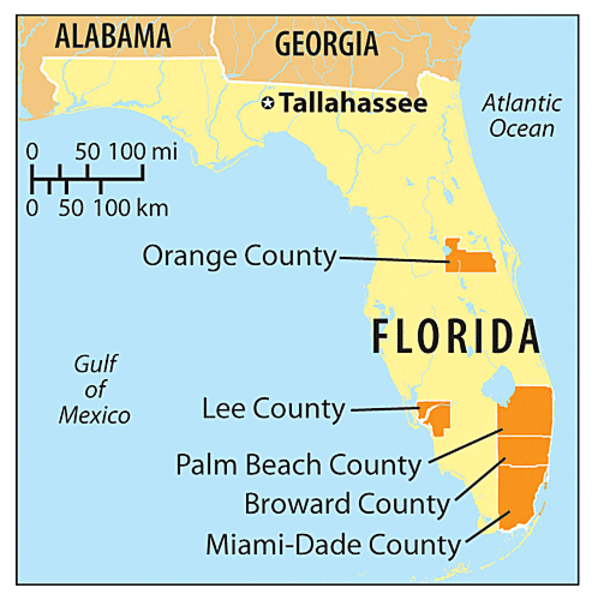Must Florida pay for felled citrus trees?
Loading...
| FORT LAUDERDALE
A jury is set to begin deliberations Monday in a case that could cost the Florida Department of Agriculture tens of millions of dollars for cutting down backyard citrus trees over the objections of homeowners.
At issue in the three-week trial is how much compensation the state should pay to 58,225 Broward County residents who lost 133,720 orange, grapefruit, tangerine, lemon, and lime trees in a controversial program aimed at preventing the spread of citrus canker disease.
The case is being closely watched because it is the first of five class-action lawsuits seeking full compensation from the state government for its canker eradication program. More than 577,000 backyard citrus trees were destroyed from 2000 to 2006 in Broward, Miami-Dade, Palm Beach, Lee, and Orange counties, although the trees were never determined to have the canker disease.
Instead, state officials ordered that every citrus tree within a 1,900-foot radius of a confirmed diseased tree be cut down and removed. Residents received a $100 payment for the first tree cut, and $55 for each additional citrus tree destroyed.
The state justified the expansive eradication zone as a precaution to bring the canker outbreak under control before it spread to the 65 million trees in Florida's commercial citrus groves.
Homeowners fought the action in court, complaining that their beloved backyard citrus trees were being destroyed without any proof that the trees were, in fact, diseased.
In February, Circuit Judge Ronald Rothschild rejected the Department of Agriculture's defense that it was using the government's police powers to protect the state's food supply from a public nuisance. The judge said the state has the power to remove diseased trees, but that the Florida constitution requires the government to pay "full compensation" when healthy trees are removed as part of the program.
A jury was empaneled to decide how much compensation would be full compensation for the destroyed trees.
Agriculture Department lawyer Wesley Parsons told the jurors in closing arguments on Friday that residents should receive "zero" compensation because their trees were exposed to canker and had no value. "The trees within the 1,900-foot-radius were doomed," he said, because it was only a matter of time before they, too, would become diseased.
Mr. Parsons likened the spread of citrus canker to the spread of wildfire. Trees in the path of the flames have no value, he said. "A menace is approaching. It is not only going to debilitate the tree in the backyard, it is also going to debilitate other trees in the neighborhood," he told the jurors.
Nancy LaVista, a West Palm Beach lawyer for the residents, told the jury that the state had no evidence that the destroyed trees were infected. "If they truly believed those trees were infected a new arc would be drawn at 1,900 feet," she said.
Ms. LaVista said the trees must be valued as healthy trees at the time they were destroyed. "It's about money," she said. "It's about the state having to come up with money."
Robert Gilbert, a Coral Gables lawyer also representing the residents, urged the jury to assign an individual value for each destroyed tree. He presented a compensation matrix with values ranging from $20 for a 1-foot-tall tree to $930 for a 10-foot tree. Mr. Gilbert suggested the jurors make downward adjustments based on the condition of the tree and the tree's location.
Citrus canker is a bacterium that forms blotches on fruit and leaves, according to scientists. It is spread from tree to tree by wind-driven rain, they say. The disease can cause some fruit to drop early and can affect the productivity of a tree. But researchers say it does not destroy or degrade the food or juice value of the fruit, nor does it kill the tree.
Florida was largely canker-free until the 1990s when, agriculture officials believe, someone in Miami-Dade County planted an infected tree from South America. The initial eradication effort involved 125-foot-radius cut-down zones. But as canker continued to spread, the zone was increased to 1,900 feet, prompting outcries and lawsuits from residents.
Despite the massive cut-downs, the eradication effort failed and canker is now said to be widespread throughout Florida. The state stopped cutting down backyard citrus trees in January 2006.
Citrus is a $3.7 billion industry in Florida, second only to tourism. Despite the spread of canker, yields are up this year and there are 82 million trees in commercial groves now – 17 million more than during the six-year backyard eradication effort.
Parsons, the Department of Agriculture's lawyer, painted a grim picture for the jurors of a citrus industry being ravaged by canker and two other diseases. "The prognosis for citrus in Florida is poor," he said. "Trees are dying."
"Citrus is part of the heritage of Florida. It is part of our food supply. It is a vital part of Florida's economy," he said. "It must be protected and was protected by the Department of Agriculture."
Gilbert urged the jurors to focus on awarding full compensation. He held up a half-gallon carton of orange juice in one hand and a half-pint carton in the other. "If the government takes this [half gallon] from you," he said, "they can't replace it with this [half pint]."
He said the state constitution guarantees full compensation when the government takes private property for public use.
"They took [the residents'] property and now they have to pay the bill to keep this guarantee sacred," he said.





